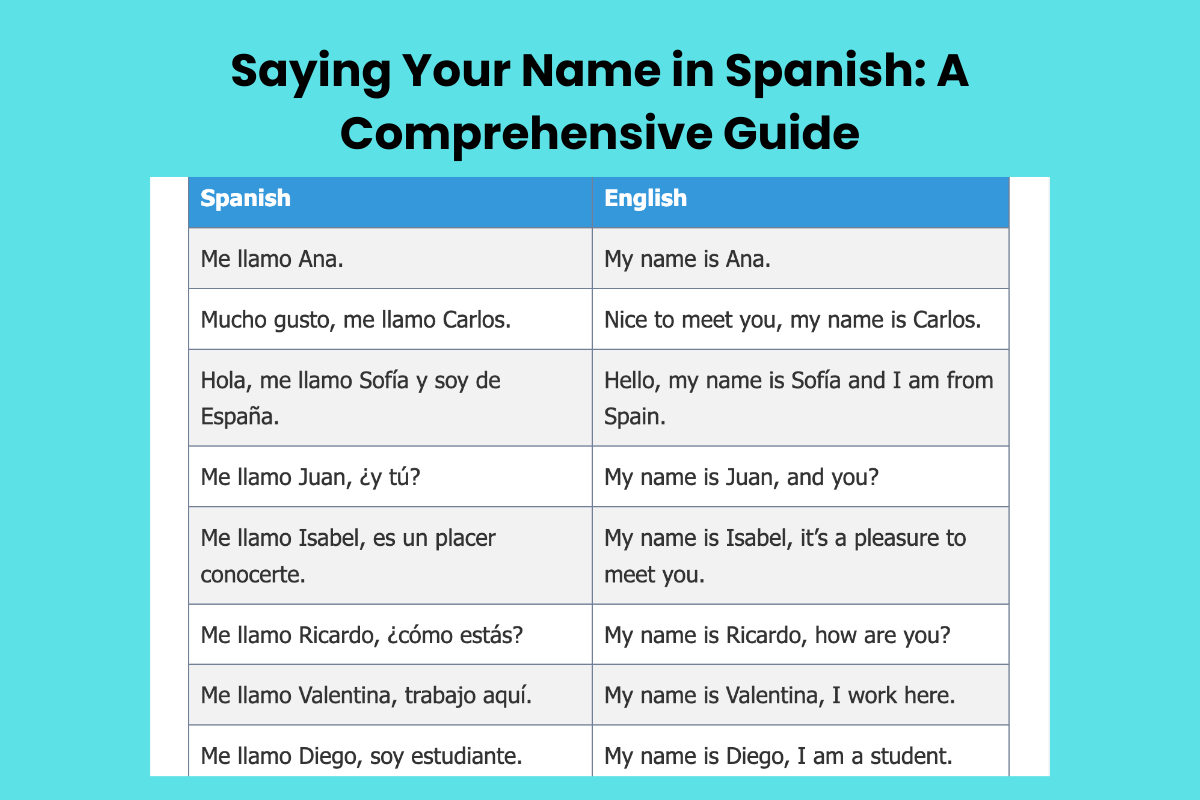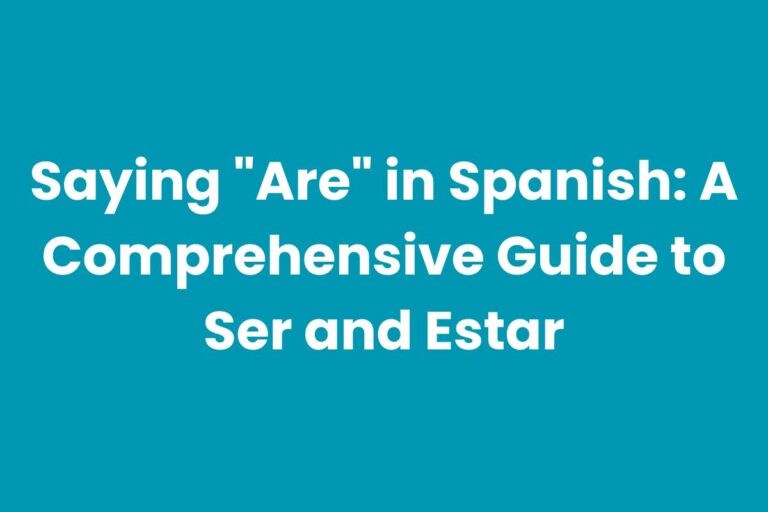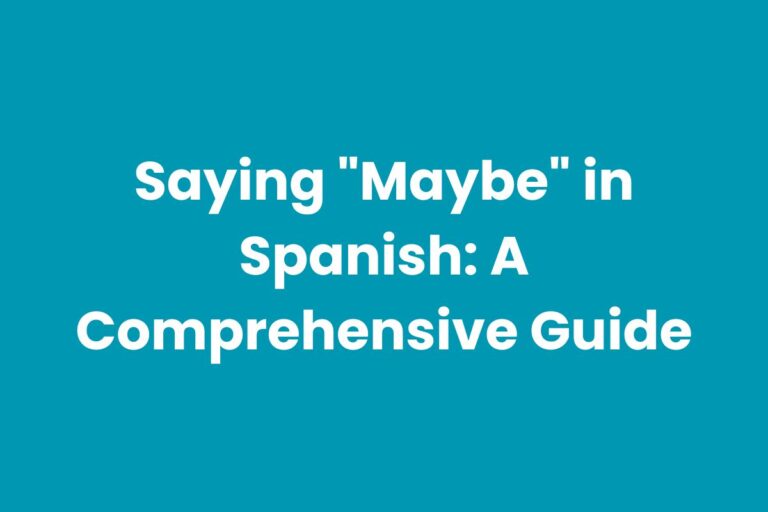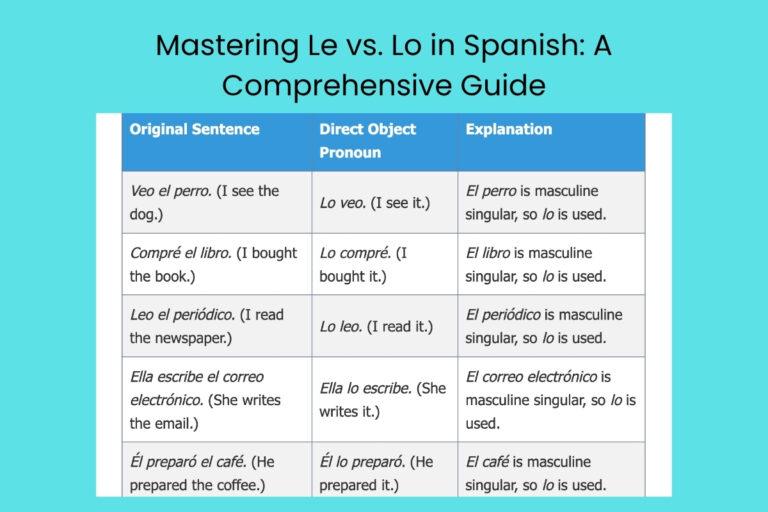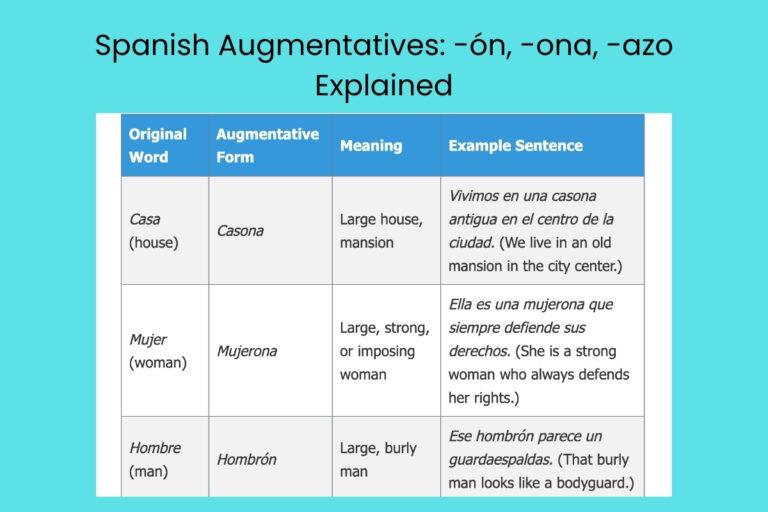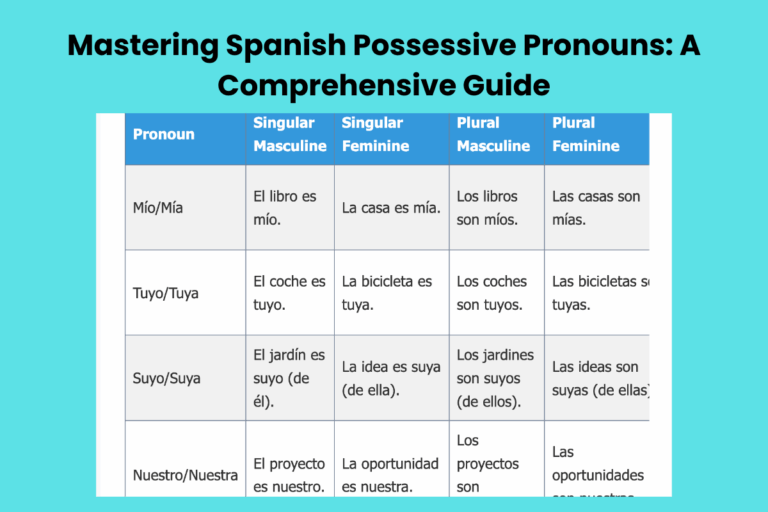Saying Your Name in Spanish: A Comprehensive Guide
Learning how to introduce yourself is one of the first and most crucial steps in mastering any new language. In Spanish, stating your name goes beyond a simple translation; it involves understanding grammatical nuances and cultural context.
This article offers a detailed exploration of the various ways to say “My name is” in Spanish, providing you with the tools to introduce yourself confidently and correctly. Whether you’re a beginner or an advanced learner, this guide will help you navigate the intricacies of Spanish introductions.
Understanding how to say your name in Spanish is fundamental for basic communication, building relationships, and navigating social situations. This guide is perfect for students, travelers, and anyone interested in learning Spanish.
By the end of this article, you will be equipped with the knowledge and confidence to introduce yourself effectively in Spanish.
Table of Contents
- Introduction
- Definition: Saying “My Name Is” in Spanish
- Structural Breakdown
- Types and Categories
- Examples
- Usage Rules
- Common Mistakes
- Practice Exercises
- Advanced Topics
- FAQ
- Conclusion
Definition: Saying “My Name Is” in Spanish
The phrase “My name is” in Spanish can be expressed in several ways, each with its own nuance and context. The most common translations are “Me llamo,” “Mi nombre es,” and “Soy.” Understanding the subtle differences between these options is crucial for effective communication.
“Me llamo” literally translates to “I call myself.” It is a reflexive verb construction, indicating that the action (calling) is performed on oneself. This is perhaps the most frequently used and natural way to introduce yourself in Spanish.
“Mi nombre es” translates directly to “My name is.” It is a more formal and direct way of stating your name. While perfectly acceptable in any situation, it might sound slightly more stilted compared to “Me llamo” in casual conversation.
“Soy” translates to “I am.” While seemingly simple, it is often used to introduce yourself, especially in informal settings. It’s akin to saying “I’m [name]” in English. However, context is important, as “Soy” can also be used for other identifications beyond just your name.
Structural Breakdown
Each of the phrases used to say “My name is” in Spanish has a specific grammatical structure. Understanding these structures will help you use them correctly and confidently.
“Me llamo” consists of the following components:
- Me: This is a reflexive pronoun, indicating that the action of calling is directed back to the speaker.
- Llamo: This is the first-person singular form of the verb “llamar,” which means “to call.”
The structure is reflexive, meaning the subject and the object of the verb are the same. This is why “Me llamo” literally means “I call myself.”
“Mi nombre es” is a more straightforward construction:
- Mi: This is a possessive adjective, meaning “my.”
- Nombre: This is the noun “name.”
- Es: This is the third-person singular form of the verb “ser,” which means “to be.”
This structure is declarative, simply stating that “my name is” something.
“Soy” has the simplest structure:
- Soy: This is the first-person singular form of the verb “ser,” which means “to be.”
In this case, the verb “ser” links the subject (implied “yo,” meaning “I”) with the noun (your name).
Types and Categories
There are three primary ways to say “My name is” in Spanish: “Me llamo,” “Mi nombre es,” and “Soy.” Each has its own level of formality and usage context.
Me llamo
“Me llamo” is the most common and often considered the most natural way to introduce yourself in Spanish. It is suitable for both formal and informal situations, making it a versatile choice for learners. The reflexive construction adds a subtle nuance of familiarity.
This form is widely used in everyday conversations and is generally preferred when meeting new people. It’s also commonly used in professional settings when a slightly more relaxed tone is appropriate.
Mi nombre es
“Mi nombre es” is a more formal way of saying “My name is.” While grammatically correct and perfectly acceptable in any situation, it tends to be used in more formal contexts or when a higher degree of politeness is required.
You might use this phrase when introducing yourself in a business meeting, addressing someone older or of higher status, or in situations where formality is emphasized. It’s a safe and respectful option that conveys professionalism.
Soy
“Soy” is the most informal way to introduce yourself. It’s suitable for casual conversations with friends, family, or acquaintances. It’s similar to saying “I’m [name]” in English.
However, it’s important to note that “Soy” can also be used to describe other characteristics or identities. Therefore, context is crucial to ensure that your intention is clear.
For example, if you are at a party and someone asks who you are, simply saying “Soy [name]” is perfectly acceptable.
Examples
Understanding how to use these phrases in context is essential. The following examples illustrate how to use “Me llamo,” “Mi nombre es,” and “Soy” in various situations.
“Me llamo” Examples
The following table provides examples of how to use “Me llamo” in different contexts. These examples demonstrate the versatility and common usage of this phrase.
| Spanish | English |
|---|---|
| Me llamo Ana. | My name is Ana. |
| Mucho gusto, me llamo Carlos. | Nice to meet you, my name is Carlos. |
| Hola, me llamo Sofía y soy de España. | Hello, my name is Sofía and I am from Spain. |
| Me llamo Juan, ¿y tú? | My name is Juan, and you? |
| Me llamo Isabel, es un placer conocerte. | My name is Isabel, it’s a pleasure to meet you. |
| Me llamo Ricardo, ¿cómo estás? | My name is Ricardo, how are you? |
| Me llamo Valentina, trabajo aquí. | My name is Valentina, I work here. |
| Me llamo Diego, soy estudiante. | My name is Diego, I am a student. |
| Me llamo Camila, ¿en qué puedo ayudarte? | My name is Camila, how can I help you? |
| Me llamo Martín, soy nuevo en la ciudad. | My name is Martín, I am new in the city. |
| Me llamo Elena, encantada de conocerte. | My name is Elena, delighted to meet you. |
| Me llamo Javier, ¿eres de aquí? | My name is Javier, are you from here? |
| Me llamo Andrea, ¿nos conocemos? | My name is Andrea, do we know each other? |
| Me llamo Pablo, ¿tienes un minuto? | My name is Pablo, do you have a minute? |
| Me llamo Lucía, soy la nueva profesora. | My name is Lucía, I am the new teacher. |
| Me llamo Sergio, ¿qué tal? | My name is Sergio, how’s it going? |
| Me llamo Patricia, ¿todo bien? | My name is Patricia, is everything alright? |
| Me llamo Óscar, ¿cómo te va? | My name is Óscar, how’s it going with you? |
| Me llamo Beatriz, ¿qué haces? | My name is Beatriz, what are you doing? |
| Me llamo Guillermo, ¿todo en orden? | My name is Guillermo, is everything in order? |
| Me llamo Antonia, mucho gusto en conocerte. | My name is Antonia, it’s a pleasure to meet you. |
| Me llamo Salvador, un placer. | My name is Salvador, a pleasure. |
| Me llamo Teresa, ¿cómo te llamas? | My name is Teresa, what’s your name? |
| Me llamo Vicente, soy el doctor. | My name is Vicente, I am the doctor. |
| Me llamo Rosario, ¿en qué puedo servirte? | My name is Rosario, how can I help you? |
“Mi nombre es” Examples
The following table provides examples of how to use “Mi nombre es” in different contexts. These examples illustrate the more formal usage of this phrase.
| Spanish | English |
|---|---|
| Mi nombre es Alejandro. | My name is Alejandro. |
| Buenas tardes, mi nombre es Carmen. | Good afternoon, my name is Carmen. |
| Mi nombre es Rafael, soy el gerente. | My name is Rafael, I am the manager. |
| Mi nombre es Gabriela, ¿en qué puedo ayudarle? | My name is Gabriela, how can I help you? (formal) |
| Mi nombre es Fernando, un placer conocerlos. | My name is Fernando, a pleasure to meet you all. |
| Mi nombre es Dolores, soy la directora. | My name is Dolores, I am the director. |
| Mi nombre es Ignacio, soy el abogado. | My name is Ignacio, I am the lawyer. |
| Mi nombre es Manuela, soy la secretaria. | My name is Manuela, I am the secretary. |
| Mi nombre es Santiago, soy el ingeniero. | My name is Santiago, I am the engineer. |
| Mi nombre es Florencia, soy la arquitecta. | My name is Florencia, I am the architect. |
| Mi nombre es Humberto, soy el contador. | My name is Humberto, I am the accountant. |
| Mi nombre es Margarita, soy la bibliotecaria. | My name is Margarita, I am the librarian. |
| Mi nombre es Eusebio, soy el profesor. | My name is Eusebio, I am the professor. |
| Mi nombre es Adela, soy la jefa. | My name is Adela, I am the boss. |
| Mi nombre es Román, soy el supervisor. | My name is Román, I am the supervisor. |
| Mi nombre es Catalina, soy la representante. | My name is Catalina, I am the representative. |
| Mi nombre es Leopoldo, soy el asesor. | My name is Leopoldo, I am the advisor. |
| Mi nombre es Consuelo, soy la consejera. | My name is Consuelo, I am the counselor. |
| Mi nombre es Benjamín, soy el consultor. | My name is Benjamín, I am the consultant. |
| Mi nombre es Remedios, soy la enfermera. | My name is Remedios, I am the nurse. |
| Mi nombre es Socorro, soy la médica. | My name is Socorro, I am the doctor. |
| Mi nombre es Prudencio, soy el farmacéutico. | My name is Prudencio, I am the pharmacist. |
| Mi nombre es Baltasar, soy el programador. | My name is Baltasar, I am the programmer. |
| Mi nombre es Melchor, soy el analista. | My name is Melchor, I am the analyst. |
| Mi nombre es Gaspar, soy el técnico. | My name is Gaspar, I am the technician. |
“Soy” Examples
The following table provides examples of how to use “Soy” in different contexts. These examples illustrate the informal usage of this phrase.
| Spanish | English |
|---|---|
| Soy Laura. | I’m Laura. |
| Hola, soy Daniel. | Hello, I’m Daniel. |
| Soy Patricia, ¿y tú? | I’m Patricia, and you? |
| Soy Roberto, un gusto. | I’m Roberto, a pleasure. |
| Soy Elena, encantada. | I’m Elena, delighted. |
| Soy Manuel, ¿qué tal? | I’m Manuel, how’s it going? |
| Soy Gloria, mucho gusto. | I’m Gloria, nice to meet you. |
| Soy José, ¿cómo estás? | I’m José, how are you? |
| Soy Carmen, ¿todo bien? | I’m Carmen, is everything alright? |
| Soy Antonio, ¿qué haces? | I’m Antonio, what are you doing? |
| Soy Mercedes, un placer conocerte. | I’m Mercedes, a pleasure to meet you. |
| Soy Francisco, ¿de dónde eres? | I’m Francisco, where are you from? |
| Soy Isabel, ¿nos vemos luego? | I’m Isabel, see you later? |
| Soy Rafael, ¿qué te parece? | I’m Rafael, what do you think? |
| Soy Consuelo, ¿todo en orden? | I’m Consuelo, is everything in order? |
| Soy Vicente, ¿necesitas ayuda? | I’m Vicente, do you need help? |
| Soy Rosario, ¿qué te trae por aquí? | I’m Rosario, what brings you here? |
| Soy Prudencio, ¿cómo te va hoy? | I’m Prudencio, how’s it going today? |
| Soy Baltasar, ¿qué planes tienes? | I’m Baltasar, what plans do you have? |
| Soy Melchor, ¿tienes tiempo para hablar? | I’m Melchor, do you have time to talk? |
| Soy Gaspar, ¿qué estás leyendo? | I’m Gaspar, what are you reading? |
| Soy Margarita, ¿te gusta la música? | I’m Margarita, do you like music? |
| Soy Eusebio, ¿eres nuevo aquí? | I’m Eusebio, are you new here? |
| Soy Adela, ¿quieres tomar algo? | I’m Adela, do you want to have something? |
| Soy Román, ¿me acompañas? | I’m Román, will you join me? |
Usage Rules
While the three phrases are generally interchangeable, there are certain rules and contexts where one might be more appropriate than the others. Consider the level of formality and the specific situation.
Formality:
- “Mi nombre es” is the most formal.
- “Me llamo” is neutral and versatile.
- “Soy” is the most informal.
Context:
- Use “Mi nombre es” in professional settings, when addressing someone older or of higher status, or in situations where formality is emphasized.
- Use “Me llamo” in most everyday situations, as it is a common and natural way to introduce yourself.
- Use “Soy” in casual conversations with friends, family, or acquaintances.
It’s also important to consider regional variations. While these phrases are widely understood throughout the Spanish-speaking world, some regions may prefer one over the others.
Listening to native speakers and observing their usage patterns can provide valuable insights.
Common Mistakes
One common mistake is using the wrong verb conjugation. For example, using “Me llamo es” instead of “Me llamo” is incorrect. The reflexive pronoun “me” already indicates that the action is performed on oneself, so the verb “ser” (to be) is not needed in this construction.
Another mistake is using “Soy” in formal situations where a more polite introduction is required. While not grammatically incorrect, it might be perceived as too casual or even disrespectful in certain contexts.
Here are some examples of common mistakes and their corrections:
| Incorrect | Correct | Explanation |
|---|---|---|
| Me llamo es Juan. | Me llamo Juan. | The reflexive pronoun “me” already implies “I,” so adding “es” (is) is redundant. |
| Mi nombre llamo Juan. | Mi nombre es Juan. | The correct structure is “Mi nombre es” (My name is). |
| Yo soy llamo Juan. | Me llamo Juan. or Soy Juan. | The phrase “Yo soy llamo” is grammatically incorrect. |
| Soy en la reunión. | Mi nombre es [name], estoy en la reunión. | While “Soy [name]” is correct, adding “en la reunión” (in the meeting) requires the verb “estar” (to be) to indicate location. |
Practice Exercises
Test your understanding with the following practice exercises. Fill in the blanks with the correct phrase (“Me llamo,” “Mi nombre es,” or “Soy”) to complete the sentences.
Exercise 1: Fill in the Blanks
| Question | Answer |
|---|---|
| Hola, _______ Ana. | Soy Ana. |
| Mucho gusto, _______ Carlos. | Me llamo Carlos. |
| Buenas tardes, _______ Sofía. | Mi nombre es Sofía. |
| _______ Juan, ¿y tú? | Me llamo Juan, ¿y tú? |
| _______ Isabel, es un placer. | Me llamo Isabel, es un placer. |
| _______ Ricardo, ¿cómo estás? | Me llamo Ricardo, ¿cómo estás? |
| _______ Valentina, trabajo aquí. | Me llamo Valentina, trabajo aquí. |
| _______ Diego, soy estudiante. | Me llamo Diego, soy estudiante. |
| _______ Camila, ¿en qué puedo ayudarte? | Me llamo Camila, ¿en qué puedo ayudarte? |
| _______ Martín, soy nuevo en la ciudad. | Me llamo Martín, soy nuevo en la ciudad. |
Exercise 2: Choose the Correct Phrase
Choose the most appropriate phrase (“Me llamo,” “Mi nombre es,” or “Soy”) for each situation.
| Situation | Correct Phrase |
|---|---|
| Introducing yourself at a formal business meeting. | Mi nombre es |
| Introducing yourself to a new friend at a party. | Soy |
| Introducing yourself to a colleague at work. | Me llamo |
| Introducing yourself to a professor after class. | Mi nombre es |
| Introducing yourself to a cashier at a store. | Me llamo |
| Introducing yourself to other students in a language class. | Me llamo |
| Introducing yourself to a family member of a friend. | Me llamo |
| Introducing yourself to a doctor at a hospital. | Mi nombre es |
| Introducing yourself to a police officer. | Mi nombre es |
| Introducing yourself to a child at a playground. | Soy |
Exercise 3: Translation
Translate the following sentences to Spanish using the most appropriate phrase.
| English | Spanish |
|---|---|
| Hello, my name is John. | Hola, me llamo John. |
| Good evening, my name is Maria. | Buenas noches, mi nombre es Maria. |
| I’m Peter, nice to meet you. | Soy Peter, mucho gusto. |
| My name is Elizabeth, I am the new representative. | Mi nombre es Elizabeth, soy la nueva representante. |
| My name is David, how can I help you? | Me llamo David, ¿en qué puedo ayudarte? |
| Hello, I’m Susan. | Hola, soy Susan. |
| Good morning, my name is Robert. | Buenos días, mi nombre es Robert. |
| I’m Emily, what’s your name? | Soy Emily, ¿cómo te llamas? |
| My name is Michael, I am a student. | Me llamo Michael, soy estudiante. |
| Good afternoon, I’m Jessica. | Buenas tardes, soy Jessica. |
Advanced Topics
For advanced learners, exploring regional variations and idiomatic expressions can further refine your ability to introduce yourself in Spanish.
In some regions, you might hear phrases like “Quien les habla es…” (The one who speaks to you is…) as a more formal way of introducing yourself, particularly in public speaking or presentations. However, this is less common in everyday conversation.
Additionally, understanding the cultural context of introductions is crucial. In some Hispanic cultures, it is customary to exchange a brief greeting and inquire about the other person’s well-being before stating your name.
This shows respect and builds rapport.
Furthermore, learning how to introduce others is also important. Phrases like “Te presento a…” (I present to you…) or “Quiero presentarte a…” (I want to introduce you to…) are useful for facilitating introductions between people.
FAQ
- Is it okay to use “Soy” in a formal setting?
While grammatically correct, using “Soy” in a formal setting might be perceived as too casual. It is generally better to use “Mi nombre es” in such situations to convey respect and professionalism.
- What is the difference between “Me llamo” and “Mi nombre es”?
“Me llamo” is a reflexive construction that literally means “I call myself.” It is a common and versatile way to introduce yourself. “Mi nombre es” directly translates to “My name is” and is more formal.
- Can I use “Me llamo es” instead of “Me llamo”?
No, “Me llamo es” is grammatically incorrect. The reflexive pronoun “me” already implies “I,” so adding “es” (is) is redundant.
- Is there a regional preference for one phrase over another?
Yes, some regions may prefer one phrase over the others. Listening to native speakers and observing their usage patterns can provide valuable insights. However, all three phrases are widely understood throughout the Spanish-speaking world.
- How do I introduce someone else in Spanish?
You can use phrases like “Te presento a…” (I present to you…) or “Quiero presentarte a…” (I want to introduce you to…) to introduce others.
- What is the most common way to say “My name is” in Spanish?
“Me llamo” is the most common and often considered the most natural way to introduce yourself in Spanish.
- Is it rude to use “Soy” when meeting someone for the first time?
It depends on the context. If the situation is informal, such as meeting someone at a party, “Soy” is perfectly acceptable. However, in more formal settings, it is better to use “Me llamo” or “Mi nombre es.”
- How do I respond when someone tells me their name in Spanish?
You can respond with phrases like “Mucho gusto” (Nice to meet you) or “Encantado/a” (Pleased to meet you). Remember to use “Encantada” if you are female and “Encantado” if you are male.
- Can I use “Yo soy [name]”?
While grammatically correct, “Yo soy [name]” is less common than “Soy [name].” The pronoun “Yo” (I) is often omitted because the verb conjugation already indicates the subject.
- Are there any other ways to say “My name is” in Spanish?
While “Me llamo,” “Mi nombre es,” and “Soy” are the most common ways, you might also hear phrases like “Quien les habla es…” (The one who speaks to you is…) in more formal settings, although this is less frequent.
Conclusion
Mastering the art of introducing yourself in Spanish is a fundamental skill for any language learner. Understanding the nuances between “Me llamo,” “Mi nombre es,” and “Soy” allows you to navigate various social and professional situations with confidence. By considering the level of formality and the specific context, you can choose the most appropriate phrase and make a positive first impression.
Remember to practice these phrases in different scenarios and listen to native speakers to further refine your understanding. Don’t be afraid to make mistakes – they are a natural part of the learning process.
With consistent effort and attention to detail, you will be well on your way to introducing yourself fluently and confidently in Spanish. Embrace the journey and enjoy the process of learning this beautiful language!

